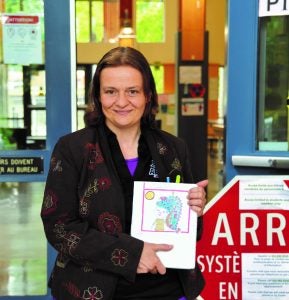 NORTH VANCOUVER—Before COVID-19 hit, Patricia Richetto had worked at École André-Piolat for 14 years. It was her comfort zone. The life-changing pandemic brought negativity and stress, but she not only coped, she conquered.
NORTH VANCOUVER—Before COVID-19 hit, Patricia Richetto had worked at École André-Piolat for 14 years. It was her comfort zone. The life-changing pandemic brought negativity and stress, but she not only coped, she conquered.
Prior to the pandemic Richetto didn’t even have a computer at home and was not familiar or comfortable with technology. Because her work as an education assistant switched to remote, online learning, the school sent a computer to her home. In the beginning she was frustrated. Despite a steep learning curve, Richetto learned how to use the computer with help from teachers and others in her school who were patient and supportive.
Now, working with the computer is a regular part of her life. As an EA, Richetto usually works with special needs kids and had many students with complex needs. She worked with 10 students from four classes. One of the challenges of working remotely was developing a schedule that worked for everyone. It took about a week to come up with a proper schedule. Answering parents’ emails was also an important part of her at-home work.
In the midst of all this, Richetto’s 22-year-old son, who was in Montreal for military training, contracted COVID-19. He got very ill, lost a lot of weight and went into isolation for one month. When he was finally able to come home, he was no longer contagious, but remained sick for a long time. He has since recovered and is working at a restaurant while looking for work in his field.
Despite personal challenges, Richetto worked to remain positive throughout. She went for lots of walks during the suspension of in-class learning and got to know her neighbours. She took a twelve-week course studying on the weekend and at night to earn a certificate to teach gifted children. “I tried to find something positive,” said Richetto.
Learning the computer and how to do Zoom calls enabled her to contact a niece and nephew that she hadn’t spoken with for years. They started having Skype meetings and exchanged photos. They spent time together online. Richetto met her brother and sister, niece and nephew and their children in Montreal this summer. “It’s been wonderful to see their little kids. I’m very happy that I was able to take something so rewarding from this pandemic,” she said.
Art has been a big part of keeping positive. She worked with students on weekly journals and they put the drawings into the school newspaper. Richetto created a cartoon featuring a little girl in different situations. She put together a podcast for the kids and an interactive book for children.
Her advice to her students is to stay hopeful and live day by day. Richetto encouraged students to do a rainbow drawing to put in the window. “It’s good to continue to support each other. We help each other and move forward together.”
Being back at school is not without its own challenges, with all the new rules, schedule changes, and wearing masks. “Being in school is difficult,” said Richetto “Although it’s stressful, I’m very happy to be back and working with students.”
This translated article is also available in French on the CUPE 4227 website.

 LANGLEY—CUPE 1851 member Troy Tardiff, a custodian at Shortreed Community School in Langley, has always loved working with people. Tardiff was featured recently in a
LANGLEY—CUPE 1851 member Troy Tardiff, a custodian at Shortreed Community School in Langley, has always loved working with people. Tardiff was featured recently in a  PENTICTON—CUPE 523 member John Johnson, a custodian at Penticton High School (PenHi), was selected by the
PENTICTON—CUPE 523 member John Johnson, a custodian at Penticton High School (PenHi), was selected by the